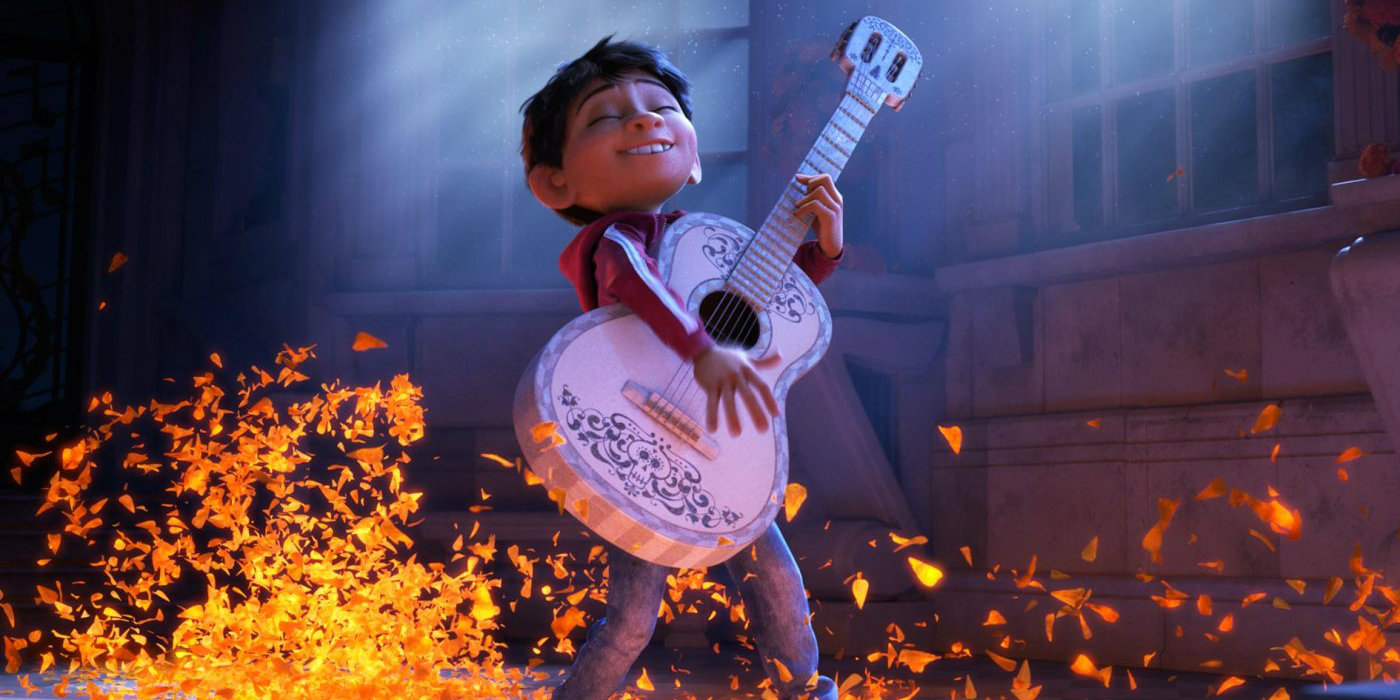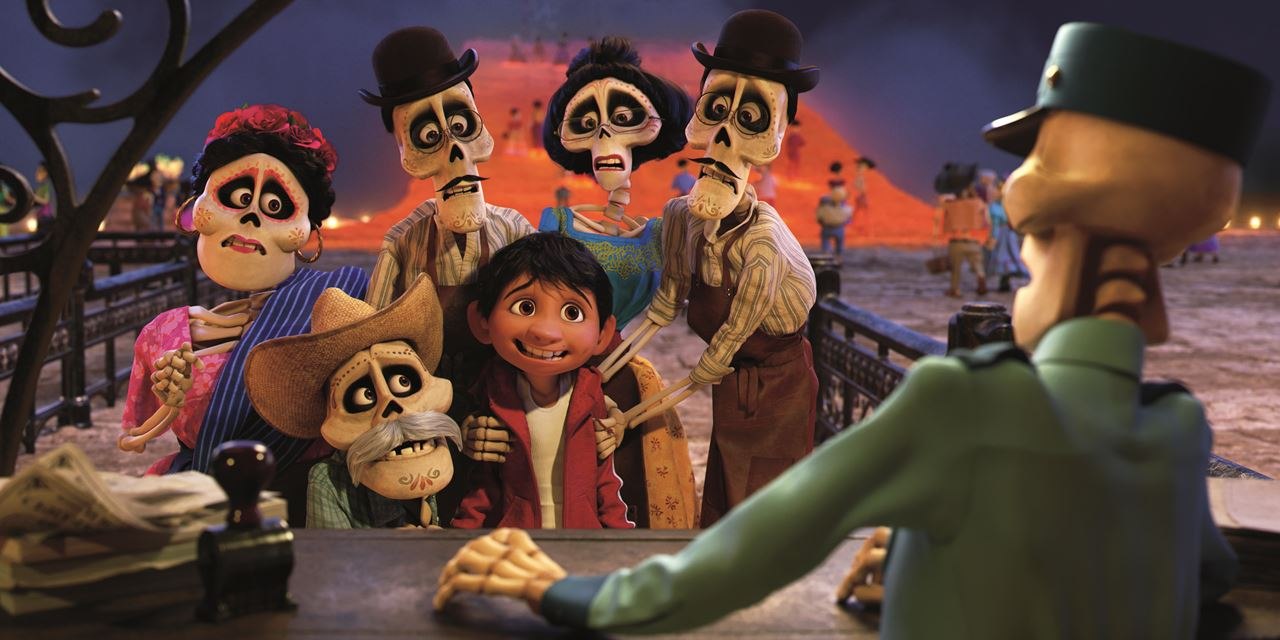Pixar’s new movie, Coco, is a surprisingly effective emotional roller coaster.
I say it’s surprising because, after 19 movies, we should all know Pixar’s plot playbook by heart, since it rarely changes. (And that’s not just because every Pixar movie follows three-act structure — so does nearly every Hollywood film.)
I’ll explain the standard Pixar plot outline in a second, but first I should clarify something:
Following a successful plot formula isn’t necessarily a bad thing. (For reference, Marvel does something very similar, and their box office just keeps getting bigger.)
RELATED POST:
But as I thought about the plot of Coco, I found something odd that stood out to me:
Miguel, the lead character in Coco, doesn’t have a character arc.
In other words, Miguel doesn’t change by the end of the movie. Yes, the circumstances around him change, but he himself is essentially the same character he is when the movie begins… with one slight tweak that I’ll address in a moment.
However, when I started to analyze why the absence of a major change for Miguel felt so strange, it led me to another, darker realization about Pixar movies altogether, and their weird recurring theme.
But before we explore theme, let’s start by clarifying why Coco‘s character arc (or lack thereof) is so unusual.
******** WARNING: Mild spoilers ahead for Coco ********

I’m about to not change at aaaaaaaaaall… [strum]
When Is A Lead Character NOT a Lead Character?
Like most Pixar films, Coco follows a proven formula:
- Misunderstood hero pursues his/her passion
- Someone (usually family) stands in his/her way
- Hero’s internal flaw creates an interpersonal conflict
- Hero’s interpersonal conflict creates an external conflict
- Hero rectifies his/her internal flaw
- Hero’s newfound self-awareness resolves the interpersonal conflict
- Hero and his/her new allies overcome their external conflict
- Hero’s support system drastically expands due to his/her self-improvement
For example, if we go back to the plot of Toy Story, where this formula started, we find:
- Passion: Woody wants to be Andy’s top toy
- Obstacle: Buzz threatens to usurp Woody’s status as Andy’s top toy
- Internal Flaw: Woody’s ego…
- Interpersonal Conflict: … causes him to try to get rid of Buzz…
- External Conflict: … which leads to Woody AND Buzz getting captured by Sid
- Rectify Flaw: Woody realizes he’s been jealous and insecure…
- Resolve Interpersonal Conflict: Woody and Buzz work together to escape Sid
- Overcome External Conflict: Woody and Buzz get home to Andy
- Support System Expands: Woody and Buzz co-lead Andy’s toys as a friendly partnership
However, compared to standard “hero’s journey” movies, Coco is a little unusual.
First, it’s not named after the hero (Miguel). It’s named after his great-great-grandmother, who appears in the film as a supporting character and a plot device.
(Un-Fun Fact: Pixar originally intended to name the film after the Mexican celebration Día de los Muertos (Day of the Dead), which features prominently in the plot. But after much-deserved outrage when Disney tried to trademark the name of the holiday, they chose to simply rename the film instead.)
And yes, Miguel is a worthy and well-defined hero.
He’s brave, conflicted, and he does overcome his one defining flaw (stubbornness) by finally realizing there is something more important in life than personal glory. In fact, critic Shea Serrano rightly calls Coco a depiction of Mexican culture that Latinx audiences can be unabashedly proud of. That’s a big win in this newly-conscious era of inclusive representation in pop culture.
But while Miguel’s journey is spectacular and emotional… he’s not actually the person who changes the most as a result of it. Instead, it’s Miguel’s family who change their entire belief system, personal identity, and worldview because of his actions.
Thus, Coco is technically the story of how Miguel’s family changed because he insisted on not changing.
Coco isn’t the first time Pixar has played this card — see Ratatouille, WALL-E, or Brave for similar outcomes — but it may be their most effective take on this theme yet.
Still, “defy your family and stay true to what you think makes you special” is a strange lesson for a family movie, no? It’s almost like Pixar is trying to teach kids about more than just the value of individuality, resilience, and acceptance.
And that leads me to the second, darker thread that runs through most Pixar movies:
The World Is a Lie

HI, OUR ENTIRE PLOT IS BASED ON A MISUNDERSTANDING
Like the original, darker fairy tales that Disney’s sanitized empire of family-friendly revisions was built on, Pixar’s cinematic universe is linked by one thread:
Everything you believe is suspect.
From Toy Story through Coco, nearly every Pixar film revolves around a public belief that is eventually revealed to be untrue. Only by seeing through this fiction do the characters learn to work together and evolve toward a better shared future based on a newer, “truer” belief.
Don’t believe me? Just consider the central fallacy in some of the biggest Pixar movies, like:
- Toy Story: Nothing ever changes
- A Bug’s Life: We’re all stuck in a life role we can’t escape
- Toy Story 2: Nothing ever changes
- Monsters, Inc.: The unknown is dangerous
- Finding Nemo: The unknown is dangerous
- The Incredibles: The world is better off without extraordinary people
- Cars: Personal success is the most important goal
- Ratatouille: We’re all stuck in a life role we can’t escape
- WALL-E: Humans have no responsibility to care for the Earth
- Up: You’re better off alone
- Inside Out: The only valid emotion is happiness
- Coco: We’re all stuck in a life role we can’t escape
Notice a few recurring themes?
“Nothing ever changes”… “We’re all stuck in a life role we can’t escape”… “The unknown is dangerous”…
What’s the converse?
“Things change”… “We can be whatever we want”… “The unknown can be wonderful”…
Who usually needs to learn these lessons in a Pixar movie?
As often as not, it’s the people who prevent the lead character from realizing his/her true nature. Which, in a way, makes Pixar an agency of change not just for kids but for their families, too. (So maybe Coco being the story of Miguel’s family’s change isn’t all that surprising after all.)
But… what do the specifics of those plot fallacies really mean?
Trust, but Verify

HELLO, I am also not what I seem! (Except adorable. I am that.)
In A Bug’s Life, the insects believe they’re all stuck in a caste system only because some of them control the others by force.
In Inside Out, Joy believes Sadness is “bad” only because Joy has never been able to process anything other than happiness as being “good” or useful.
And in Coco, Miguel’s family believes music is bad only because they all grew up believing that their musician ancestor abandoned their family to pursue fame and fortune instead.
It’s only through Miguel’s adventure that his true heritage, and the opportunity to heal his family, is finally revealed. And he accomplishes this by literally disproving a fact (actually, two) that the entire world (and his family) have been laboring under for decades.
Once the central lie in Coco is revealed, the public immediately believes the new truth. (Which, yes, is both too convenient and a little too trusting.) But it’s only the revelation of this new larger truth that helps Miguel bring the smaller (yet more meaningful) truth back to his family, which completes their cathartic arc of change.
Realizing this, I can’t help but see the ultimate irony in Pixar’s movie universe:
Pixar, a company that makes millions of dollars by making up stories for children, is simultaneously training children to disbelieve every story they’re told.
Check Out More Posts Like This…
How the Villains Explain the Point of Pixar’s Incredibles Movies
The Unfortunate Lesson Storytellers Should Learn from Missing Link


0 Comments